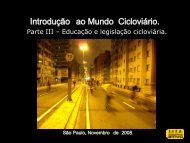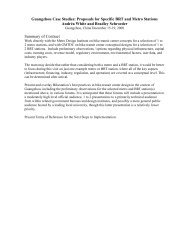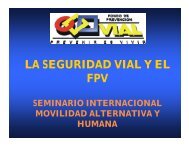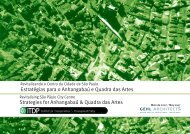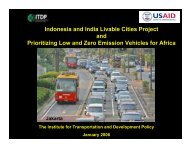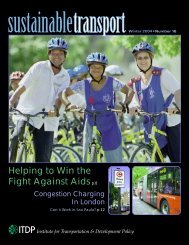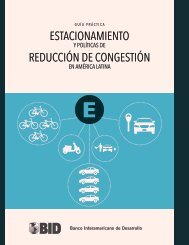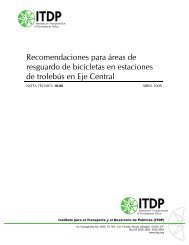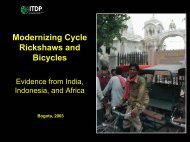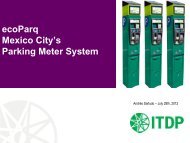Making TransJakarta a World Class BRT System - ITDP | Institute for ...
Making TransJakarta a World Class BRT System - ITDP | Institute for ...
Making TransJakarta a World Class BRT System - ITDP | Institute for ...
You also want an ePaper? Increase the reach of your titles
YUMPU automatically turns print PDFs into web optimized ePapers that Google loves.
o Allow safer pedestrian at-grade crossings (when on level is recommended).<br />
o Reduce the number of phases to improve capacity. Usually capacity can be<br />
increased by 50% just by not allowing direct right turns <strong>for</strong> all movements.<br />
o Control parking in the corridor.<br />
VI.2.a. Station location at intersection<br />
Typically we consider that bus stations should be more than 150 meters away from the<br />
intersection, to provide additional capacity <strong>for</strong> turning vehicles and to increase the<br />
number of mixed traffic vehicles able to clear the light in a single signal phase.<br />
In fact, the distance is a function of the green time at the signal, where the distance L ><br />
2.5*TG, where TG is green time. For most of the corridor, the green time is around 50<br />
seconds, so, so 2.5*60 = 150m.<br />
As intersections are infrequent, occurring only every 2 km on average, except in the<br />
central area, there is little difficulty in keeping bus station stops away from intersections.<br />
VI.2.b. Location of bus stations at non-intersections<br />
For bus stops not at intersections, the bus station should be located near the attracting<br />
point but not directly in front of it. Directly in front, there will tend to be a lot of non-<br />
<strong>BRT</strong> buses, taxis and paratransit vehicles and pedestrians congregating. To reduce<br />
congestion, so we split the <strong>BRT</strong> bus stop and the remainder lines bus stop.<br />
Bus stop<br />
Bus lane<br />
Demand generator<br />
VI.2.c. Width of the Mixed Traffic Right of Way<br />
Mixed traffic lanes need to be wide enough to accommodate a reasonable growth of the<br />
general traffic in the corridor less the bus lines cut from the corridor. This width should<br />
be proportional to peak hour directional pcu volume. The following table shows the<br />
correspondent width needed <strong>for</strong> some typical sections:<br />
Final Recommendations <strong>for</strong> <strong>TransJakarta</strong>, p. 92



